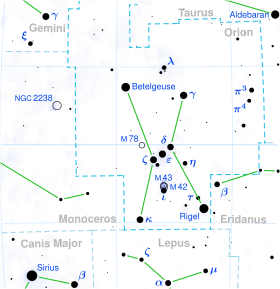15 Orionis facts for kids
15 Orionis is a fascinating star located in the constellation Orion. It's a type of star called an F-type subgiant, which means it's bigger and brighter than a normal star like our Sun, but not yet a giant star. You can see it in the night sky, though it's not one of the brightest stars.
| Observation data Epoch J2000 Equinox J2000 |
|
|---|---|
| Constellation | Orion |
| Right ascension | 05h 09m 41.95770s |
| Declination | 15° 35′ 50.0410″ |
| Apparent magnitude (V) | 4.82 |
| Characteristics | |
| Spectral type | F2IV |
| U−B color index | +0.19 |
| B−V color index | +0.32 |
| Astrometry | |
| Radial velocity (Rv) | +28.79 km/s |
| Proper motion (μ) | RA: -2.71 mas/yr Dec.: -15.75 mas/yr |
| Parallax (π) | 6.06 ± 1.97 mas |
| Distance | approx. 500 ly (approx. 170 pc) |
| Absolute magnitude (MV) | -0.04 |
| Details | |
| Mass | 3.42 M☉ |
| Radius | 5.9 R☉ |
| Luminosity | 300 L☉ |
| Surface gravity (log g) | 3.75 cgs |
| Temperature | 7,161 K |
| Metallicity [Fe/H] | +0.21 dex |
| Rotational velocity (v sin i) | 60 km/s |
| Other designations | |
|
BD+15°752, CCDM J05097+1536AB, GC 6306, HIP 24010, HR 1676, HD 33276, SAO 94359, WDS J05097+1536AB
|
|
| Database references | |
| SIMBAD | data |
Contents
Star Facts
15 Orionis has an apparent magnitude of 4.82. This number tells us how bright a star looks from Earth. The lower the number, the brighter the star. For comparison, the brightest star in the night sky, Sirius, has an apparent magnitude of about -1.46.
Distance from Earth
This star is very far away! It's about 540 light years from Earth. A light year is the distance light travels in one year. Since light travels incredibly fast, 540 light years is a huge distance. Scientists figure out these distances using something called parallax. This is like holding your finger out and closing one eye, then the other. Your finger seems to move against the background. Stars also seem to shift slightly as Earth moves around the Sun, and this tiny shift helps us calculate their distance.
Size and Brightness
15 Orionis is much larger and brighter than our Sun.
- It has about 3.4 times the mass of the Sun.
- Its radius is nearly 6 times bigger than the Sun's.
- It shines with about 300 times the luminosity (total brightness) of the Sun.
- The surface temperature of 15 Orionis is around 7,161 Kelvin (which is about 6,888 degrees Celsius or 12,430 degrees Fahrenheit). This makes it hotter than the Sun, which is why it appears as an F-type star, often looking yellowish-white.
A Special Role for Uranus
Did you know that 15 Orionis is the southern pole star for the planet Uranus? Just like our Earth has Polaris (the North Star) pointing to its North Pole, Uranus has a star that its South Pole points towards, and that star is 15 Orionis! This means if you were standing on Uranus's South Pole, 15 Orionis would appear almost directly overhead.
Star Companions
Astronomers suspect that 15 Orionis might have a companion star, which they call "B". This means it could be part of a binary system, where two stars orbit each other. This companion is very close, making it hard to see clearly.


